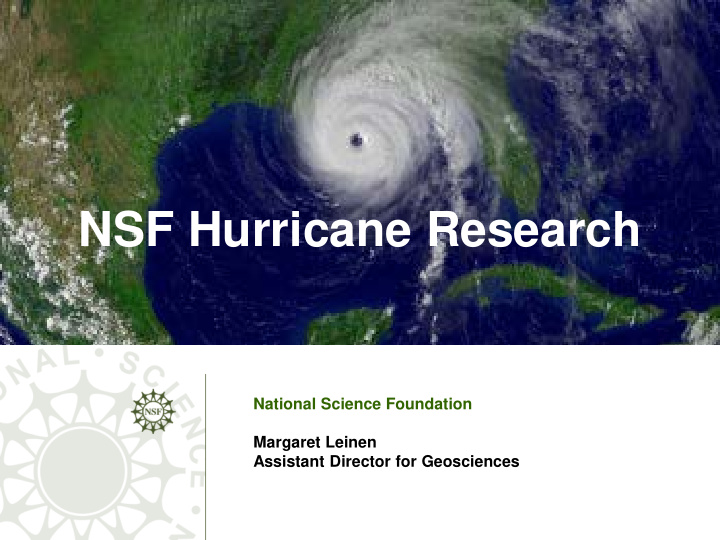



NSF Hurricane Research National Science Foundation Margaret Leinen Assistant Director for Geosciences
NSF Directorate Roles in Hurricane Research Geosciences (GEO) – Study the hurricane as a phenomenon from formation to dissipation. Conduct research on the prediction of hurricane behavior/evolution and on the impacts of hurricanes on the built and natural environments. Biological Sciences (BIO) - Study hurricane impacts on ecosystems - both terrestrial and aquatic - and human health.
NSF Directorate Roles in Hurricane Research Engineering (ENG) – Provide research into hazard response and mitigation, and how hurricanes affect infrastructure - including buildings, levees and electrical and communication systems. Social, Behavioral & Economic Studies (SBE) – Research focuses on the four stages of disaster management: mitigation, preparedness, response, and recovery.
NSF Response to Katrina Quick-response grants, called Small Grants for Exploratory Research, allowed scientists to gather perishable data from areas affected by Katrina. Close to 90 grants were awarded by NSF in the months following Katrina. • Studies of water contamination, quality and bacterial communities • Social and behavioral effects on the region’s population • Infrastructure damage assessments – including communications and electrical supply, housing, levees, and debris removal. • Ecosystem studies – from marine organisms to sediment transport
Observational Hurricane Research • During RAINEX, NSF and NOAA researchers used three instrumented aircraft to investigate both Katrina and Rita in their rapidly developing phase, obtaining unprecedented data to study intensity changes in hurricanes Right: Radar and Satellite loop of Hurricane Rita. Tracks are of NOAA and NSF sponsored research aircraft.
Hurricane Modeling Studies The Weather Research and Forecasting Model is a collaborative effort between NCAR and NOAA to design a mesoscale model that will serve the research and operational needs of the Atmospheric Science community
A Damage Model Estimate from Hurricane Katrina Wind from Numerical Forecast Likelihood of Wind Damage 10m Wind (m/s) Electric Grid Electric Grid Restoration Damage Brian Bush (NCAR/Los Alamos)
Basic Research on Meteorological Processes in Hurricanes The Loop Current and related eddies aid the intensification process of hurricanes
Is climate change affecting the intensity of hurricanes globally? Top: Power Dissipation Index and Sea Surface Temperatures in the Atlantic and Northern Pacific since 1950 Right: Global increase in Category 4 and 5 hurricanes since 1970
Hurricanes and Catastrophic Sediment Transport Impacts on: • Coastal marshes 2001 • Deltaic wetlands • Barrier islands • Local sea-level rises Right: Pre and post-hurricane pictures of the Chandeleur Islands, located approximately 100 kilometers east of the city of New Orleans. Credit: USGS 2005
LTER – Long Term Ecological Research Sites Left: The Everglades LTER site, pre and post-Hurricane Wilma 1938 Right: The Harvard Forest LTER hurricane manipulation study (bottom) is modeled on the actual impacts of a 1990 large 1938 storm (top)
Hurricane Effects on Infrastructure Effects of hurricane-force winds on long-span bridges, tanks, and fiberglass reinforced windows. Modeling and simulation of wind load for wind hazard mitigation. Study on the uplift forces on residential construction during hurricanes (with the International Hurricane Research Center, NIST, NOAA, and various Florida-state institutions).
Modeling Hurricane Effects One of NSF’s major cyberinfrastructure investments, Network for Earthquake Engineering Simulation (NEES), will produce data valuable for hurricane research. A distributed network of experimental tools, including shake tables, and wave basins, can be use to model the effects of hurricanes, high winds, and water damage on buildings and infrastructure.
Social and behavioral aspects of hurricane disasters Social and behavioral sciences seek ways to translate forecasts and measurements by physical scientists and engineers into effective plans and actions by people. Studies include: • risk-taking decisions, and who does or does not prepare for disaster • areas that are vulnerable to disaster due to human decisions • the effect of communications, warnings and alerts on populations • how physical forecasts translate into risks for specific people/assets
Recommend
More recommend